Photos by Kip Miller
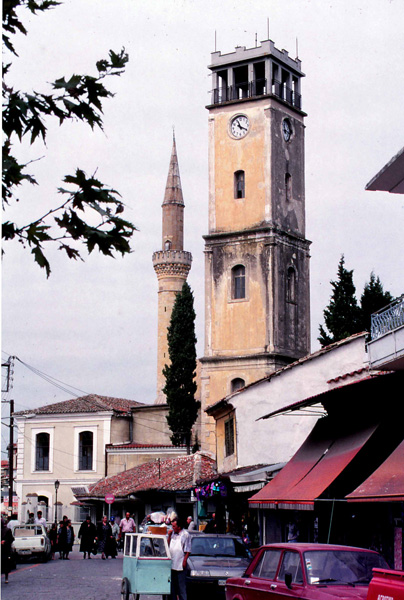
Yeni Cami, Komotiní’s central mosque, is flanked by an elegant clock tower dating from 1884
A muezzin is chanting the afternoon call to prayer atop Komotiní's
central mosque. The sound is amplified, overtaking all competing noises.
I sip my frappé at a cafeníon across the street and watch
several men wearing embroidered skullcaps and red velvet fezzes enter
the mosque. A dozen women draped in flowing white caftans trail behind
them, their faces concealed under colorful yashmaks. I have to remind
myself that I am in Greece. Feeling light years away from the comforts
of Athens, I am totally immersed in this exotic backwater called Thrace.
No region in Greece is more multi-layered than its northeastern corner. Bordered by Bulgaria and the Rhodope Mountains in the north, the Évros River and Turkey in the east, Greek Macedonia in the west and the North Aegean Sea in the south, Thrace is a melting pot of ethnicities, with sizable minority populations. It has a storied history complete with ancient sites that were once home to fierce Thracian tribes, Greek colonists and Roman conquerors. Later incursions created Byzantine strongholds, Turkish towns, Bulgarian villages and Jewish enclaves. Thrace is also a center of ecotourism, with protected sites that are home to rare birds of prey and some of Europe's last stands of virgin forests.
It is one
week earlier and we have just loaded up on brochures at a government tourist
office in Thessaloníki. My husband and I and our English friend,
Elinor, pack up our rental car and head east on a misty June morning.
It is the year of the millennium and our second trip to Thrace, but this
time we're delving into its remote corners. A modern highway parallel
to the Via Egnatía, the road built by the Romans nearly 2,000 years
ago, quickly brings us to Kavala, gateway to Thrace.
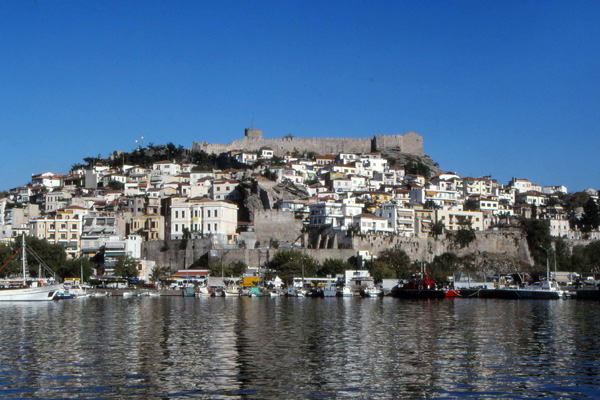
Kavála serves as the gateway to Thrace, crowned by a massive Byzantine citadel with towers and ramparts.
In the foreground, the peninsula of Panagía still evokes its Anatolian roots.
Known as Neápolis during the Roman era, Kavála is a major port in the region. "Apparently, Paul landed here in the year 49 to spread Christianity in nearby Philippi," I remark. Many centuries later, Suleiman the Magnificent built a winding aqueduct, transporting water down to Kavála from Mount Símvolo in the north. Looming over the city is a massive Byzantine citadel complete with towers and ramparts. But perhaps most evocative is Panagía, the old Anatolian peninsula located just above the port. Here sits the historic home of Pasha Mehmet Ali who ruled Kavála with an iron fist in the 18th century. His descendant Farouk became the king of Egypt until he was toppled by Nasser in the 1952 rebellion.
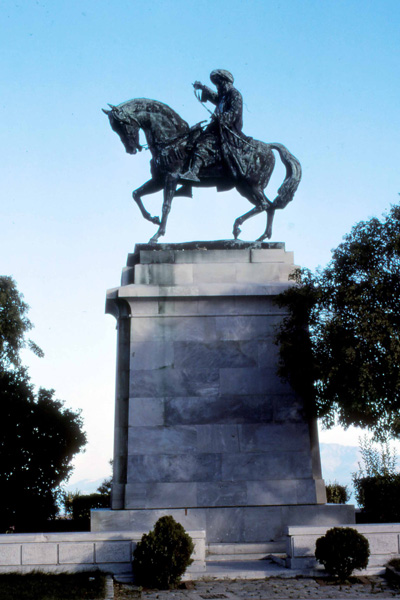
Albanian-born Pasha Mehmet Ali distinguished himself in the administration of Kavála from 1805-1848.
Known for his military prowess, he is regarded as the father of modern Egypt.
"Eláte, parakaló (come in, please)," motions the
attendant with a flick of his worry beads. Mehmet Ali's elegant residence
has wood-paneled reception rooms, a harem, stables and gardens that evoke
palaces in Istanbul. Nearby, the multi-domed Imaret, once a Koranic and
charitable center, gleams in the noonday sun. "I believe there are
plans to turn it into a luxury hotel," says the well-spoken caretaker
sitting next to a no-admittance sign. We stroll past a bronze statue of
Ali astride a horse, brandishing his curved sword in the air, then continue
down to the harbor area crowded with fishing boats. Nets are strung out
everywhere and enterprising fishmongers are cutting prices on their remaining
catch. A large ferry is loading cars and passengers, about to depart for
Thasos, Macedonia's only island. "Thasos will have to wait for another
trip," I sigh.
Not far from the city's municipal park, Kavála's archaeological museum displays some exemplary finds from Philippi, the city built by the father of Alexander the Great to protect the region's gold mines from avaricious Thracian tribes. "Take a look at this shiny gold wreath! Can you believe it is 2300 years old?" asks my husband." We continue to the municipal museum, arriving an hour before closing--just enough time to peak at its rich costume display and a roomful of semi-abstract sculptures by Thásos-born artist Polygnotos Vagis.
After dusk the seaside is a magnet for locals and tourists who promenade up and down the quay before settling on a restaurant choice. "Káli spéra sas (good evening)," beams the diminutive proprietor of a dimly lit taverna, leading us to his last available table. We savor platters of mídia yemistá (stuffed mussels), a dish popularized by Asia Minor Greek refugees who came to Kavála during the great population exchange of 1923. Several fishermen wander in for drinks, one carrying a bouzóuki. He begins to strum as his compatriots burst into song. I recognize a wistful love melody, Mángiko, popularized by the café amán singer Andonis Dalgas: "Your seductive charms turn me on and light a fire in my heart," the fishermen wail with emotion, their eyes completely shut. I watch them down swig after swig of tsípouro (fiery grape brandy). By evening's end, bottle empty, they no longer feel love's pain!
From our open hotel window, the rhythmic sound of the sea lulls us to a deep sleep that ends abruptly at dawn with sharp outbursts of street noise. "You've got to see this," says my husband, pointing to the sun rising over an endless line of massive trucks loaded with sugar beets, corn and tobacco bound for Thrace. A cacophony of horns ensues as the trucks inch their way out of town before the city fully awakens.
The Néstos River is the western boundary of Thrace, flowing south from the Rhodope Mountains through deep gorges and woodlands, finally emptying into a delta of freshwater lakes and the Aegean. A small gauge railroad excursion can be made on the river's stony banks, taking visitors through several long tunnels between the towns of Toxótes and Stavroúpolis. The latter is distinguished by its tiny rail station and vintage Thracian houses. "This town must serve as a staging area for adventure travelers who come for hiking and canoeing expeditions," posits Elinor as we exit the area.
"It's only 76 miles to Alexandroúpolis!" I announce, noting a signpost for the capital of Thrace. Even though the road goes right past Xánthi and Komotiní, the two jewels of the region, we decide to save them for our grand finale and continue east. Alexandróuolis, once called Dedeagatch, is a young city established after the Russo-Turkish Wars in the late 19th century on the site of a small fishing village. A tall lighthouse was constructed near the port, becoming a beacon for the new metropolis. Wide roads were laid out, lined with neoclassic buildings and cathedrals. By 1897 the city was important enough to become a stop on the legendary Orient Express. But several wars ensued and possession of the city and of Thrace alternated between Turkey and Bulgaria until finally, in 1924, the Treaty of Lausanne affirmed that Western Thrace and Dedeagatch belong to Greece. The young Greek king Alexander rushed out to see it and the city was renamed in his honor. Today, Alexandróupolis is a bustling commercial center and a first stop for visitors from Bulgaria and Turkey, serving as a hub for the entire region.
Strolling on the waterfront near the old customs house, we are drawn to a lively fish auction. Dozens of colorful caïques loaded with catch are clustered by the quay. "Frésca psária, frésca psária (fresh fish)," the auctioneer bellows. He's completely encircled by shrieking housewives, restaurateurs and villagers from outlying areas anxious to get their share of the catch. A short walk from the port, the Ecclesiastical Art Museum boasts a large collection of Byzantine icons. "How interesting!" says Elinor. "I notice that most of these icons originated in Anatolia, undoubtedly brought over by Asia Minor refugees." We head to the nearby Ethnology Museum, housed in a neoclassic mansion filled with stylish displays of folk instruments, Anatolian ceramics, oil presses and farming equipment from bygone days.
It has been a long day and we are ravenous. "Try Taverna Gialós, if you like good fish," suggests the guard in the costume section. "It's right on the water, not far from the lighthouse." Ten minutes later, owner Tassos seats us at table overlooking the sea, bringing out crisp zucchini fritters for starters. We relish his grilled octopus and tsipoúra (sea bream), among the best we've ever had. At the end of the meal, a plate of fragrant ravaní (almond cake soaked in syrup) arrives, on the house. "Efharistoúme polí." We thank Tassos, vigorously shaking his outstretched hand as we exit to the twinkling waterfront.
Not far from Alexandroúpolis lies the Évros Delta, ranked as one of the most important wetlands in Europe. It sits on the estuary of the Évros River which rises in Bulgaria and serves as the border between Turkey and Greece. The Delta is a protected habitat under the Ramsar Convention and filled with sandy islets, wet meadows and lagoons that are home to more than 300 plant species including rare orchids and water lilies. "You must come back in autumn to see the saltwort on the banks of the lagoons," says the friendly official. "It turns deep red and is quite beautiful!"
But it is the animal life that brings people here and hundreds of species of birds have been recorded. In the distance we spot clusters of geese, swans and herons. Above our heads, white-winged birds circulate in formation. "Every spring huge populations of birds migrate from Africa to Europe and they come here to feed," explains another attendant. "In a couple of months we'll have many pelicans and storks stopping by."
Since most
of the Delta area is restricted to visitors, we continue north to the
Dadiá Forest, a protected woodland thick with aged oaks and pines
and an ecotourism center managed by the Word Wildlife Fund. A regularly
scheduled tour van leaves the Dadiá information center for several
lookouts and organized footpaths where one can observe rare birds of prey.
"I am taking you to Mavroména Lookout where you can watch
raptors soar on thermals that rise out of the canyon," announces
a British-trained ranger. "Besides vultures and eagles, you will
also see falcons, hawks, buzzards and the rare black stork. There are
some raptors here that are not found anywhere else in Europe," he
adds. Many of the vultures look pretty scary to me. I'm convinced they
could lift a sheep or a goat up in the air with their huge talons. The
ranger reads my face. "You're safe here," he assures me with
a smile.
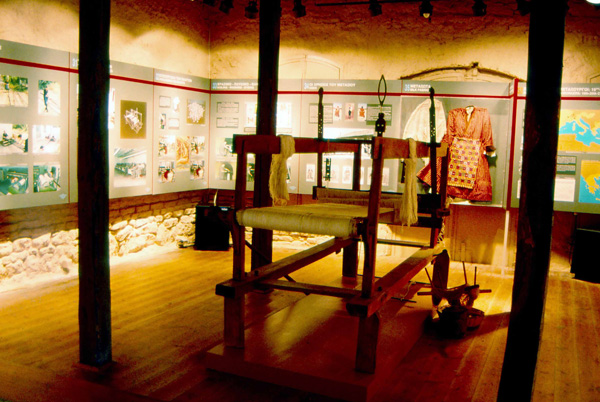
Souflí’s silk museum houses an award-winning display showcasing the entire process of silk-making.
By the time we get to Souflí, Thrace's silk capital, it is well
past lunchtime. Since many sites close early in Greece, we head directly
to the popular Silk Museum housed in an elegant old mansion. "Distihós,
then éxoume révma (unfortunately, we don't have electricity),"
says the woman behind the ticket desk. We ask if we could try again in
a couple of hours. "Málista (of course)," she nods. When
we return to the museum, the lights are on. "Prohorísete (proceed),"
the woman flashes a big smile. A well-executed display highlights the
entire process of silk-making: from bags of silkworm cocoons to the spinning
of thread on a locally made machine, much faster than a hand-held spindle.
There are reeling and warping machines plus samples of locally made items.
A sign on the wall notes that Ioanna Papantoniou, director of the Peloponnesian
Folklore Foundation, was a major consultant on the project. I remember
meeting the talented Ioanna years earlier in Los Angeles. "How wonderful
that she was able to add her expertise to the silk exhibit!" I tell
Elinor.
We head north
toward Didymótecheio, situated on the banks of the Erythropótamos,
a tributary of the Évros. Its name derives from its twin hills
crowned with crumbling Byzantine walls and towers. Between these hills
the town spreads theater-style over the remains of Trajan's city of Plotinópolis,
built in the second century in honor of his virtuous wife, Plotina.
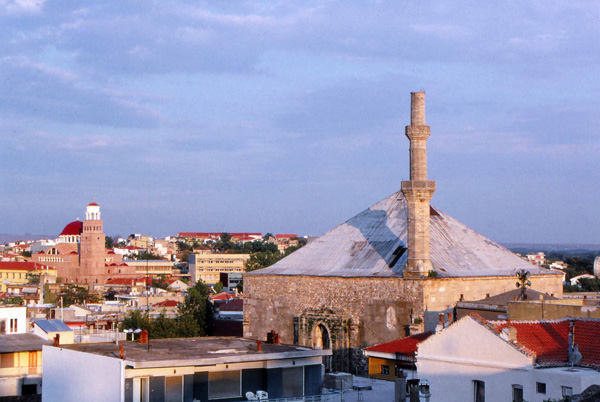
Built as a pyramid, Didymótecheio’s Sultan Celebi Mosque is the oldest Islamic structure on European soil.
Inside, an exquisitely carved dome is inlaid with delicate wood carving.
At a modest hotel on the outskirts of town, we ask for directions to Didymótecheio's
main attractions. Number one is the Celebi Sultan Mehmed Mosque, the largest
Islamic structure on European soil, dating from 1380 and built in pre-Ottoman
style. We find it in the center of town, undergoing extensive restoration.
"Take a look at the size of this mosque!" exclaims Elinor. "It
has the shape of a giant pyramid and the walls are about seven feet thick."
We peek inside. The prayer area is crowned by a dome inlaid with intricate
wood carvings. Near the banks of the river we approach two decaying Turkish
baths (hammams) known as "The Baths of Love and Whispers." The
site is quite evocative. "I can imagine concubines soaking in perfumed
water while eunuchs strum their ouds," I whisper to my smiling husband.
We wind through the town center, packed with narrow lanes. At a tiny jewelry shop on a side alley, the aged proprietor is quite anxious to tell us his story. "I am the last remaining Jew in Didymótecheio," he reveals as we browse through his stash of locally-made earrings. "We once had a good-sized Sephardic community here, but only a few of us survived the concentration camps. When I die, that's it."
On that somber note, we enter a music store. Vangelis, the owner, brings out a several CD selections of Thracian folk music to tempt us. We are unable to decide which to buy, so Vangelis takes the matter into his own hands. "Páme (let's go)," he says, leading us to an empty lot overlooking the town. "As xorépsoume (let's dance)," he encourages us as the music plays in his portable player. Several bystanders gather to enjoy the music. With Vangelis in the lead, they start to dance. He coaxes us to join the line as he demonstrates several variations of zonarádikos, the signature dance of the region. "Bravo, étsi (that's how it's done)," he encourages us. We return to his shop ready to buy all the CDs.
A thick morning mist is hanging over the road to Bulgaria. We pass by a large enclave of local Gypsies who have commandeered a service road off the highway with their wagons and carts displaying rugs, tablecloths, clothing and pots and pans for sale. They beckon us to stop and we walk around, checking out their wares and marveling at their high energy level. Lively Gypsy music is blaring from a transistor, nearly drowning out their conversations in Romani, a language with roots in India. "Wait! You did not buy!" a burly man admonishes us in a booming voice, finger waving in the air, as we head out empty-handed.
We are not far from the border, in the heart of the Rhodope range. Here, dense forests of Norway spruce and beech are interspersed with streams and waterfalls, transforming the region into a vast national park, a popular escape from the pressures of city life. A less traveled back road leads us southwest toward Metaxádes, continuing through woodlands to the center of Thrace. "We only have four days left," I complain, hoping that we'll have enough time to cram in all the highlights of Komotiní and Xánthi.
No city in
the region is more evocative of its Ottoman past than Komotiní.
In addition to a sizeable Turkish population, the city has a large enclave
of Pomaks, people of Bulgarian origin who were forcibly converted to Islam
and now live in small villages in the northern half of Thrace. "They
speak a dialect of Bulgarian and have their own mosques and customs,"
I explain. Turkish Gypsies (Romani) constitute another group in Komotiní.
The city also includes a small Sarakatsáni community, nomadic sheepherding
people with roots in in Epirus. After the population exchange with Turkey
in 1923, a large contingent of Pontian Greeks and Armenians from Asia
Minor also settled here, adding their own music and traditions to the
cultural mix. "Before World War II, Komotiní had a sizable
Jewish community and a beautiful 18th century synagogue," I remind
my husband. Today nearly half of the population is not Greek Orthodox
and the city reflects this diversity with mosques and specialized markets,
cultural centers and dance ensembles.

Two Greek priests set out on a shopping spree at a tinsmith shop near Iféstou Square in Komotiní,
the heart of the Muslim quarter.
The centrally located Orpheus Hotel serves as a base for exploring Komotiní.
We wander down to the municipal park and its towering World War II memorial,
"The Sword." Nearby, the Komotiní Folk Museum is housed
in a restored Thracian mansion, its walls hung with copper and brass trays,
regional instruments and costumes. We stroll to the old bazaar, not far
from Plateía Irínis near Iféstou Square, dotted with
shady cafes and tinsmith shops. This is the heart of the Muslim section,
awash with tiny streets. The area echoes old Istanbul with its elegant
Ottoman-era clock tower and pencil-thin minarets rising above the buildings.
It is Tuesday market day and swarming with shoppers. "Look over here,
lady," several vendors beckon. At a stall displaying crocheted linen
napkins, we select a large assortment for gifts. Another stall is crammed
with antique bríkes for making Greek coffee, Anatolian pitchers,
water pipes, goat bells and candlesticks, a veritable shopping paradise.
Stacks of bougátsa (phyllo pastry with cheese) line the window of a zaharoplasteíon (sweet shop) not far from the Komitiní's fortress walls. Inside, the air is redolent with exotic fragrances. Unlike the bougátsa we first tasted years earlier in Crete, this version is much sweeter, with a subtle hint of rosewater. We trudge around the old fortress searching for a fourth century inscription, "Theodosius," hidden somewhere within its crumbling walls. For strategic reasons, the fortress was sited near the old Egnatía Way and encompasses 12 towers and two entrances. Komotiní's Jewish community once worshiped at a domed synagogue within the safety of these walls.
The city's impressive archaeological museum is just minutes from Plateía Irínis, encircled by a wooded garden. Among its many treasures is a remarkable relief of Roman Emperor Maximinus Thrax on horseback. We stop to admire a clay mask of Dionysius found in Maronía and ornate gold jewelry from Mesembría, two ancient sites near Komitiní. Not far from the museum, several imposing buildings date back to the 19th century, the period when tobacco farming flourished and merchants amassed large fortunes. One mansion serves as the current headquarters of the Sarakatsáni community. "Don't forget to visit our reconstructed 'nomadic village' with beehive huts just outside of town," says the enthusiastic attendant.
Hungering for a taste of Anatolia, we head to Sultan Tepe on Vasiléos Pávlou, a traditional Turkish restaurant not far from the clock tower, tucked into a long row of eateries. "What tantalizing aromas," says Elinor as she eyes the kitchen ahead. The choices here are abundant, but we finally settle on chicken and Iskender kebabs. It is astonishing to see Greek and Turkish restaurants amicably operating side by side, their blended clientele totally at home. Greek pop music throbs in one establishment, fading out as a Turkish lament reaches a crescendo in another. The cultures collide in a harmonious mix that somehow gives me hope for a better world.
The next
afternoon, we make the short drive to Xánthi, without doubt the
most beautiful city in the region. Dating from the first century A.D.,
it was conquered by the Ottomans in 1361, yet always retained its mixed
population. Multi-cultural Xánthi became a commercial leader in
tobacco trade during the 19th century, building many warehouses, mansions
and schools. The city suffered through Balkan wars and Bulgarian annexation,
until finally after World War II, firmly back in Greek hands, it began
to thrive anew. Today, a branch of Democritus University adds youthful
vigor to Xánthi. "Did you know that Xanthi has many famous
native sons, such as the popular Greek composer Manos Hadjidakis?"
I ask. "They have a music festival in his honor every year."
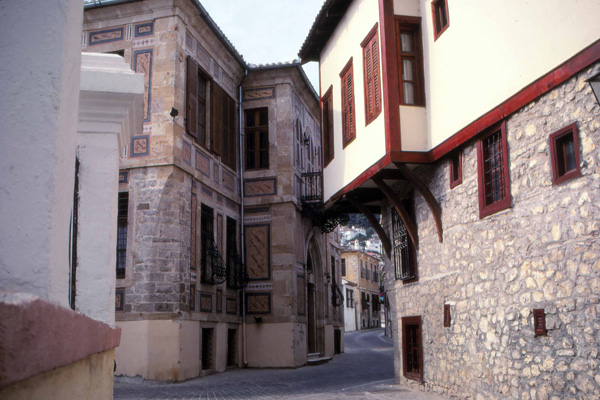
Xánthi’s old town is filled with exquisite Thracian mansions that have been lovingly restored with respect for the local architectural style. Enclosed balconies (koultoúkia) often project out to the street, nearly touching the opposite houses.
Elena, our chosen hotel near the Kósynthos River, is just minutes from the atmospheric old town. In the cool of morning, we begin a leisurely exploration of its cobbled streets, discovering tiny squares and stately mansions, many built by craftsmen from Epirus and Macedonia. "The houses seem to be renovated with respect for the original architecture," my husband notes. Many Thracian houses have enclosed balconies supported by wood beams (koultóukia) hanging over the street, as if reaching out to touch the opposite house. There is a delightful mix of belle epoque and Ottoman styles. One limestone mansion is now the Town Hall, built in 1880 by Moysis, a prominent Jewish tobacco magnate.
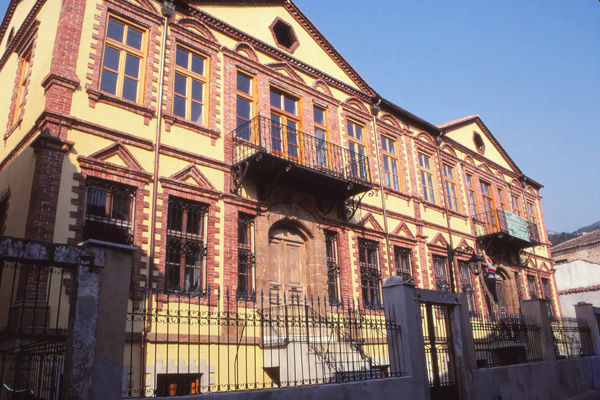
Once the residence of a wealthy tobacco merchant, The Kougioumtzóglou Mansion on
Antíka Street houses an extensive collection of folk costumes and household items.
The grandest one, the 1877 Kougioumtzóglou mansion, operates as
a folk museum, housing exceptional costumes and jewelry. But rooms adorned
with frescoed walls and elaborate, carved moldings clash with the simple
daily life of a Greek family being depicted. We climb higher to a large
square where a primary school is in session. A group of six-year-olds
rush out to play in the yard. "Káli méra," they
shout with glee, waving non-stop. Higher up the Achrian Mosque twinkles
in the sun, its minaret spiking against the blue sky. A sign in front
in Greek, English and Turkish welcomes all visitors. We wind down a narrow
lane, marveling at the integrity of the town. Near the fire brigade a
large open area houses the famous Saturday bazaar, where villagers from
surrounding towns gather to sell their produce and handicrafts. The Kósynthos
River abuts the old town, edged by a pleasant walkway with cafes and restaurants
tucked among trees. We stop for coffee and a rest. "Ach, póso
efháristo (how delightful)!" sighs an old woman sitting nearby
as she watches three ducks waddle on the banks of the river.
Xánthi's old town spills into Plateía Kentrikí, an enormous central square dominated by a tall 19th century clock tower. "Quite a scene!" exclaims my husband, aiming his camera. We stand and watch from afar. A group of boisterous students burst into song in a crowded bar, toddlers frolic by a fountain, businessmen in suits rush in and out of the National Bank of Greece, old ladies gossip in hushed tones on a long bench, and dozens of worshippers file out of a nearby cathedral. It is clear that everything and anything in Xánthi happens here, not to mention public celebrations.
Tucked into
a crowded pedestrian street, Ta Fanarákia is a busy taverna in
operation since 1948. We order lachanodolmádes (stuffed cabbage),
followed by a taste of their house made saraglí (rolled phyllo
with walnuts in syrup). Our solicitous waiter asks if we have visited
the monasteries above the old town. "Prépei na ta díte
(you should see them)," he insists.
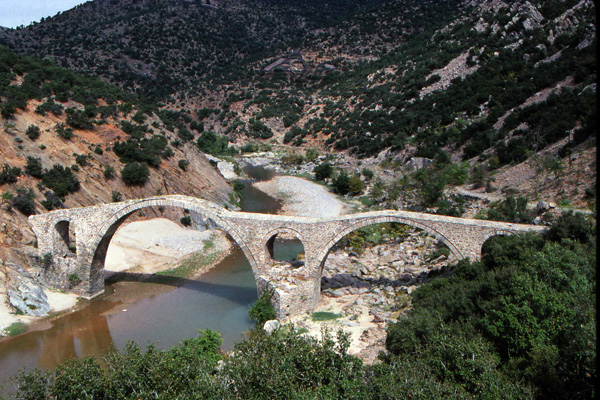
Numerous abandoned stone bridges span rivers and streams in the Xánthi countryside. These
arched constructions, much revered by the locals, were the handiwork of masons from Epirus.
We take him at his word and head out later that afternoon, crossing a
bridge over the Kosynthos to the large complex of Panagía Kalamoú,
dramatically sited on the edge of the river gorge and named for an icon
of the virgin found in a pile of straw nearby. It is very old, dating
from the iconoclastic era and rebuilt several times after earthquakes
and wars. The setting is almost primeval: footpaths lead to densely wooded
ravines and rivulets carpeted with ferns and moss. Nearby, Panagía
Archangelótissa is a male-only monastery first opened in the 11th
century and rebuilt in 1841. It houses an impressive museum in one wing,
but its rarest manuscripts are in Sophia, taken by the Bulgarians during
the last occupation of Xánthi. White-washed Pomak houses dot the
countryside, surrounded by hand-tilled fields. "Look at all the stacks
of tobacco leaves drying on frames," Elinor exclaims, pointing to
an immaculate farmstead ahead.
On our last day in Thrace it's hard to leave the old town. We stop for photos at every turn, as if we were connected to the place. A miniscule bakery wafting cinnamon and cloves tempts us with stacks of kariótes, siropiastá, soutzoúk loukoúmia, dried fruits and roasted nuts. We choose an assortment for our return journey. At the City Hall, I pick up a color booklet on Xánthi describing its annual Carnival, one of the liveliest in Greece. "The Carnival highlight is the ritual burning of Tzáros," I read out loud. "A human effigy is placed on a pile of brushwood which makes a 'tz tz tz' sound as it burns. This ancient pagan practice is supposed to ward off fleas during the summer months." I can almost visualize it: a grand ceremony held on the banks of the Kósynthos, the culmination of days of noisy revelry and colorful parades, with fire and smoke rising against the pale winter sky.
Reluctantly, we start out on our return to Thessaloníki. As we cross the Néstos, we each make a vow to return. Thrace, the forgotten corner of Greece, has totally captured our hearts.
